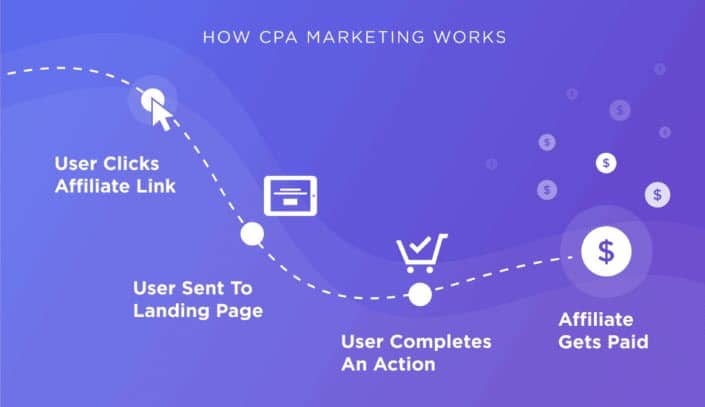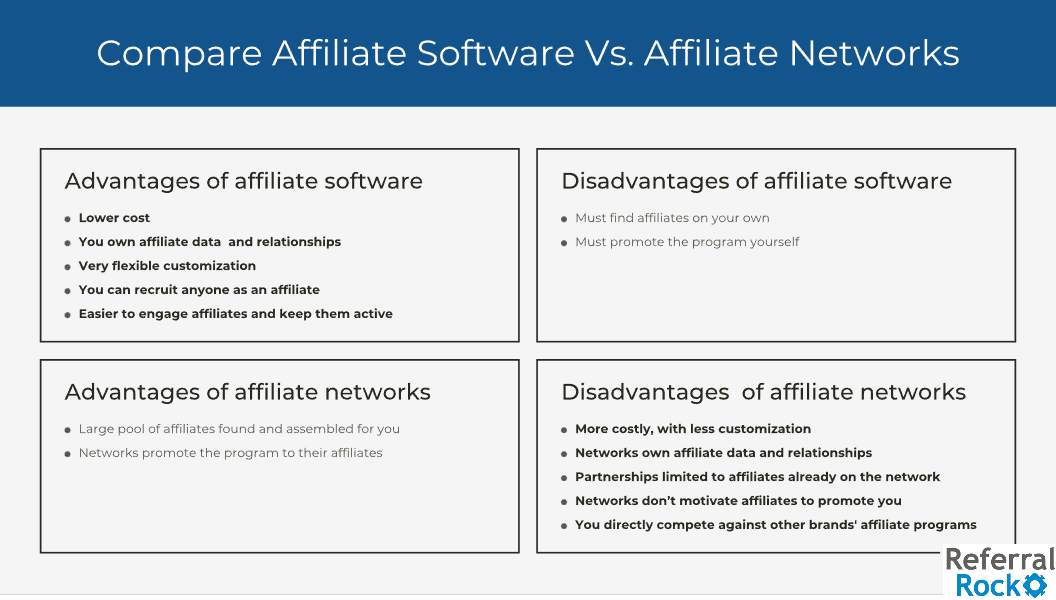Cost per action marketing, or CPA marketing, is one form of affiliate marketing. In CPA affiliate marketing, a business or advertiser will partner up with affiliates. The advertiser will then pay when a lead takes a certain action after clicking an affiliate link. In this post, we delve deeply into what to expect when starting CPA affiliate marketing as a brand, including the types you can choose from and best practices for managing affiliates.
What is CPA affiliate marketing?
CPA affiliate marketing means cost per action affiliate marketing.
In CPA affiliate marketing, you recruit affiliates, or content creators, to promote your brand on their website, blog, or social media account. They’ll place unique affiliate links on their channels that direct audience members to your website, and that track when their audience members complete certain steps.
You’ll only pay affiliates a commission when they complete a certain action, such as driving a lead, sale, trial signup, or click from their audience.
Businesses choose CPA marketing to reach a large audience that most affiliate marketers already have built for them. In addition, businesses only need to pay affiliates after an audience member of theirs takes a specific action. So, it’s low-risk – no need to pay upfront. On the other side, affiliate marketers enjoy high payouts from this type of marketing, especially if you’re awarding commissions for sign-ups or leads.
CPA vs. traditional affiliate marketing
CPA is slightly different from traditional affiliate marketing. With CPA, an affiliate can earn money for driving set actions, whether or not they ultimately achieve a sale for the brand. If an audience member takes a certain action that the business has chosen to monetize, such as signing up for a newsletter or watching videos, the affiliate gets paid right away.
CPA marketing works best for businesses with a landing page. The landing page should require users to take a clear, well-defined action, such as filling out a form or starting a trial. This way, you know that the paid action indicates significant interest in your product from the audience member.
Who is involved in CPA affiliate marketing?
CPA marketing involves the following elements:
Advertiser (business): This is the company that recruits affiliates to drive traffic to their website. They set the actions that affiliates get paid for within the CPA affiliate model.
Affiliate (publisher): An affiliate is a content creator who promotes the business’ products/services on their content channel and places trackable affiliate links in their content for CPA tracking. Every time someone clicks the link and performs the desired action, the affiliate gets a cash commission. Affiliates must have a significant and relevant audience, such as a website with quality traffic, a YouTube channel with many viewers, or a large social media following that would have interest in the business’ product or service.
Software or affiliate network: The affiliate software or affiliate network is responsible for connecting the advertiser and the affiliate. It is an interface that creates affiliate links, registers affiliates’ sales and other CPA actions, and handles payment when affiliates meet set CPA goals.
Generally, it’s better for a business to choose affiliate software over a network for the best CPA monitoring. Software gives full visibility on affiliates’ data, enables you to customize your CPA program, and lets you own your relationships with affiliates. While an affiliate network can help you connect with affiliates quickly, networks are generally more expensive and tend to withhold valuable affiliate data. You also lose out on the ability to connect closely with affiliates if you go with an affiliate network, since the network acts as a “middleman.”
Types of CPA affiliate marketing
CPA affiliate marketing can further be divided into different categories, based on the action the advertiser wants the publisher to promote. Here are the most common types of CPA affiliate marketing:
Pay per sale (PPS)
Also known as cost per sale, or CPS, this is the basic payout model when it comes to affiliate marketing. The affiliate earns a percentage of any sales they drive through affiliate links It is up to the advertiser to determine how much the affiliate will be paid. This is the recommended CPA structure for most businesses, because affiliates only get paid when money comes in. This means your brand will only invest in results that drive your bottom line, and it’s more difficult for unethical affiliates to game the system.
Pay per click (PPC)
This is an affiliate strategy where affiliates get paid based on the number of clicks on their affiliate links. This serves the affiliate marketers well, especially if they have quality traffic on social media or their blog. However, this may not be the best option for brands since they are not paying for tangible results. Also, some dishonest affiliates may find a way to generate fake clicks to get more commissions.
Pay per lead (PPL)
This is probably the best CPA strategy for B2B businesses. It involves paying affiliates if they obtain qualified leads for the merchant. The actions that leads must take for the affiliates to earn money differ heavily from business to business. They could range from downloading an eBook to requesting a quote, or from filling out a form to being manually qualified by your sales team. PPL is beneficial for both publishers and businesses.
For businesses with a long sales process, generating leads is a crucial step, so rewarding affiliates for bringing in leads makes sense. After all, this incentivizes affiliates to bring in leads whether or not those leads result in sales. For affiliates, they get to earn respectable payouts, because many merchants are willing to pay good money to have these actions taken.
It’s a good practice to pay affiliates for leads if you’re a B2B, or another business that has a long sales process. But if you pay for leads, you should also pay for sales, to reward the actions that truly contribute to your bottom line. Pay a smaller amount for leads, and a larger amount for sales.
Pay per install (PPI)
Also known as cost per install or CPI, this is an affiliate model where brands pay affiliates for every installation of an app or software program. This affiliate model is great for brands, because it is a low-risk way of acquiring new users (only pay when people actually start using your app or program). It is also great for affiliates with high-quality referrals and an audience that would benefit from installing the app or software. Some affiliates, especially influencers, conduct campaigns where they advertise certain mobile apps and share affiliate links. From these native ads, the affiliates can generate many app installs and bring in substantial passive income.
Pay per other actions
Apart from the above models where affiliates get paid, there are other ways in CPA where affiliates get paid. One of the most popular ways is when people view a certain video. Their affiliate commission may get paid according to the number of views they achieve through online marketing, or based on the number of unique visitors..
Other actions monetized in CPA affiliate marketing include (but are not limited to) filling out forms, playing a game, joining a webinar, and creating an account.
Benefits of CPA affiliate marketing
CPA affiliate marketing has many perks, both for the affiliates and the brands using these services. Here are some of the perks;
Cost efficiency: Generally, advertisers opting for CPA affiliate marketing only get to pay for results. For instance, if they deal with a mobile app, they might only pay for installs. It is cost-effective because brands avoid losing money on ads, which generally must be paid for before they know the results of the campaign. For affiliates, it means that they don’t have to spend money to start earning. Affiliates would only need to have quality traffic.
Performance measurement: CPA affiliate marketing allows for straightforward tracking of performance (especially when you’re using affiliate software). Every desired action is closely tracked because it’s registered through the affiliate link, and results in a payout for the affiliate. You aren’t left in the dark about results creators drive, like you would be if you used traditional influencer marketing.
Risk mitigation: The CPA model allows advertisers to reduce the risks involved in banner ads, organic SEO, native ads, and other forms of advertising. Advertisers get to align their costs with outcomes.
Wide reach: For better sales, brands need to reach as many people as possible. Affiliates, and especially influencers, can help advertisers reach a large and relevant new audience.
Enhanced ROI: Advertisers using this affiliate marketing model get to enjoy good ROI on their online marketing strategies. CPA affiliate marketing is precise, and it leverages the trust that audience members place in creators.
CPA affiliate marketing best practices
To achieve better results, brands must have an excellent strategy when working with CPA affiliate marketers. Here are some of the best practices to consider if you are a business leveraging this type of affiliate marketing model:
Selecting affiliates
Your business must ensure that it only works with reliable affiliates to ensure that they get conversions. Find affiliates that will resonate with your brand’s niche and audience for better results. Affiliates’ content, personality, and voice must be a good fit for your industry.
High, positive engagement from a creator’s audience is a sign they are trusted, and if they have a reputable track record as an affiliate, that’s even better. Whether they have a track record or not, they should have a concrete plan for how they’ll promote your brand when asked.
How to find affiliates? Use brand mention software to find creators and experts who have mentioned you, talk to customers you know create content, or open and advertise an affiliate application. Be sure to screen all potential affiliates with the same rigorous standards.
Building trust
There needs to be a healthy affiliate program agreement between advertisers and publishers for CPA affiliate marketing to work. If you are a business working side by side with affiliates, you might try assigning them account managers, especially for your beginner affiliates. And be sure to communicate with all affiliates regularly, including in one-on-one conversations. Create a community to share updates and build relationships with affiliates.
Choosing the right commissions
Competitive commissions will encourage your affiliates to promote your business aggressively. So, it’s good practice to check on the commissions competitors are offering.
However, you should also consider if the commissions are cost-effective for the type of leads or actions you need. The closer the monetized action is to driving revenue for your brand, the higher a commission should be. Clicks should warrant lower commissions than leads, and leads should warrant lower commissions than sales.
Utilizing analytics
Dealing with affiliates without fully tracking and analyzing their work can be quite confusing. Therefore, you need to consider getting affiliate software like Referral Rock that will help you with the analytics. Software gives you access to the detailed data you’ll need to optimize your program – access you won’t have if you go with an affiliate network. Watch your conversion rate closely so you know if your program is performing how you expect, or if it needs tweaking.
Focusing on conversions
It doesn’t matter what type of CPA affiliate marketing you choose – you need to focus most on true conversions. Even if you are monetizing other actions, ensure that the affiliate gives you qualified leads and actual sales as you work together, as those are what truly drive your bottom line.
Crafting compelling landing page content
Your landing page is the center of your affiliate marketing strategies. If you have a landing page with poor content, it would be quite difficult to make sales or compel actions, no matter what type of affiliate partners you choose to work with.
Once audiences click the affiliate’s link and end up on your website, the ball is in your court. So, make sure that your landing page is excellent enough to give you good sales and compel leads to take action. Show the value of your product or service to the specific audience you’ve targeted, make it clear what you want them to do, and end with a clear CTA to get them moving.
Staying away from unethical affiliates
Some affiliate marketers are notorious for producing fake clicks and actions, such as fake sign-ups and fake downloads. Avoid them at all costs. Always be on the lookout, and ensure that you work with affiliates who follow all the ethical and legal affiliate marketing standards.
Affiliate software vs. affiliate network: Making the right choice
You might have heard of CPA networks as a way to find affiliates and manage your program. However, affiliate networks have many more drawbacks than benefits, so they should be avoided if you’d like more control and flexibility.
- Affiliate networks charge extra fees – up to 30% of the revenue you bring in, in addition to the commissions you pay affiliates.
- Affiliate networks often have limited options to customize your program. You might not even be able to reward the actions you want to reward.
- Affiliate networks keep affiliate data for themselves, meaning you can’t access the data and use it to make meaningful decisions.
- Affiliate networks limit you to selecting affiliates already registered on the network.
- Affiliate networks control relationships with affiliates, so you don’t get to build meaningful connections.
- On affiliate networks, you’re forced to compete directly with other businesses to secure affiliates. Whoever can pay the most usually gets the most affiliates – not very cost-effective.
Fortunately, building your affiliate program with affiliate software removes these drawbacks.
- Affiliate software automates the process of tracking and rewarding affiliates, and streamlines the process of communicating and building relationships with affiliates.
- It’s far more cost-effective than an existing affiliate network. You’ll only pay for the software and for affiliate commissions – no extra fees to a network.
- You’ll be able to recruit affiliates without directly competing with other businesses, and can cuatomize the program to your unique needs.
- Software tracks affiliates’ performance in detail, so you can easily see if you’re meeting your goals.
- And it gives you full control of your data and all other aspects of running a program – with no middleman.
Note: Remember, the best use of CPA affiliate marketing is incentivizing both qualified leads and purchases. If you want to reward affiliates for driving both leads and sales, you’ll need an affiliate software that can handle these multi-step incentives – like Referral Rock.
Driving results with CPA affiliate marketing
CPA affiliate marketing creates a win-win situation for both the advertisers and the publishers. It is cost-effective and allows businesses to reach a wide audience.
Normal native ads and traditional marketing options cannot match the effectiveness of CPA affiliate marketing. However, to enjoy its perks, make sure that you consider following the above best practices in this article. You can also try out affiliate marketing solutions such as Referral Rock, to avoid the disadvantages associated with networks.
CPA Affiliate marketing FAQs
Still have questions about CPA affiliate marketing? Read through these streamlined answers.
What are CPA networks?
These are platforms that connect advertisers and publishers. CPA networks also help advertisers manage their affiliates. Unfortunately, they come with extra fees and prevent you from forming close relationships with affiliates. They may also withhold detailed data on your program’s results. It’s better to manage your own CPA affiliate program using affiliate software.
What’s the difference between CPA affiliate marketing and affiliate marketing?
While CPA marketing focuses on actions, affiliate marketing focuses on sales. This means that in CPA marketing, affiliates get paid for the actions taken, while affiliate marketing pays affiliates based on the sales they make.
What are the best actions to reward in CPA affiliate marketing?
It’s still best to focus on rewarding affiliates for qualified leads and sales in CPA affiliate marketing. A qualified lead could be one who fills out a form, signs up for a demo, or takes any other action that indicates they’re a prime candidate for purchasing.
How does CPA marketing work?
It simply works by rewarding affiliates for marketing and generating leads that take action. These actions include signing up on a site, watching videos, downloading an app, and many more.





